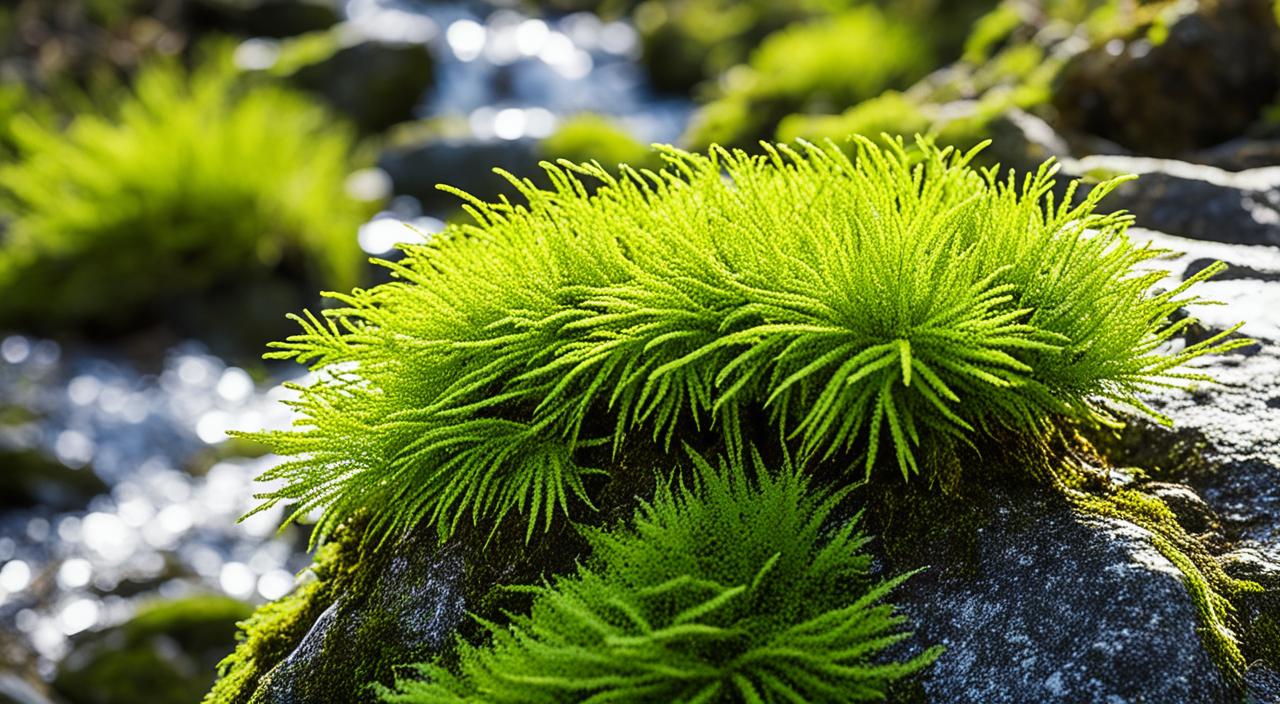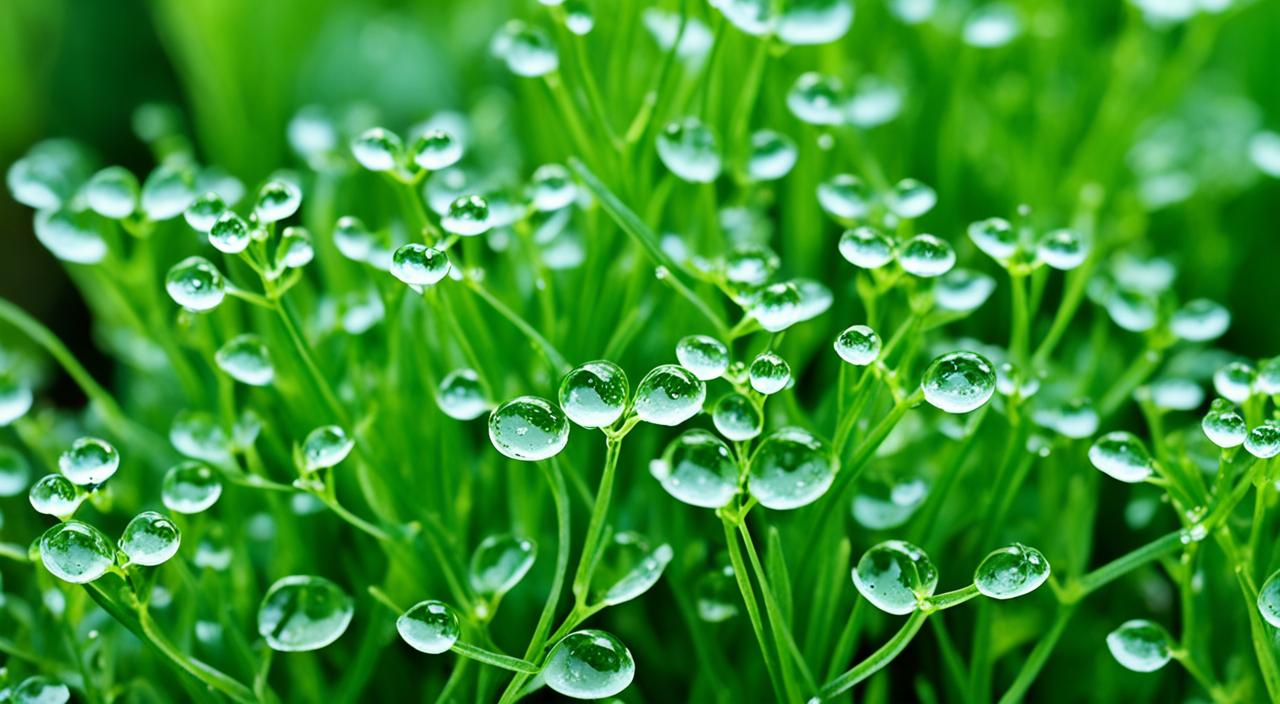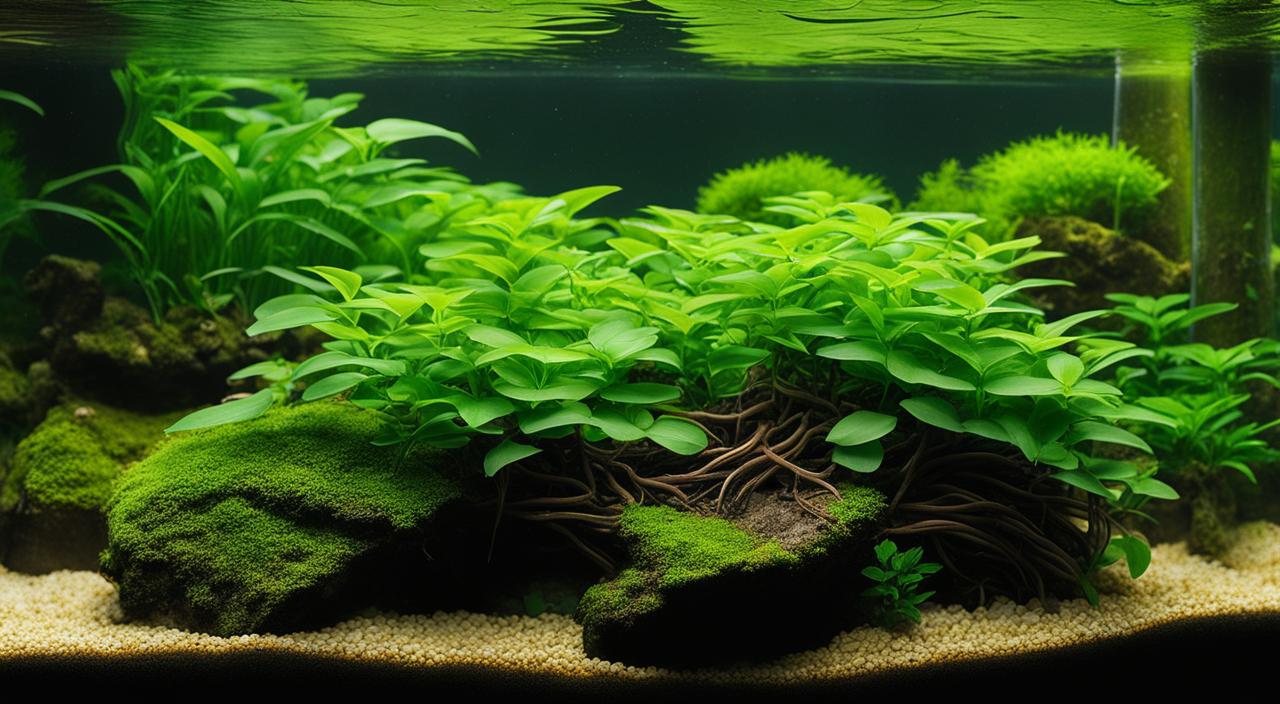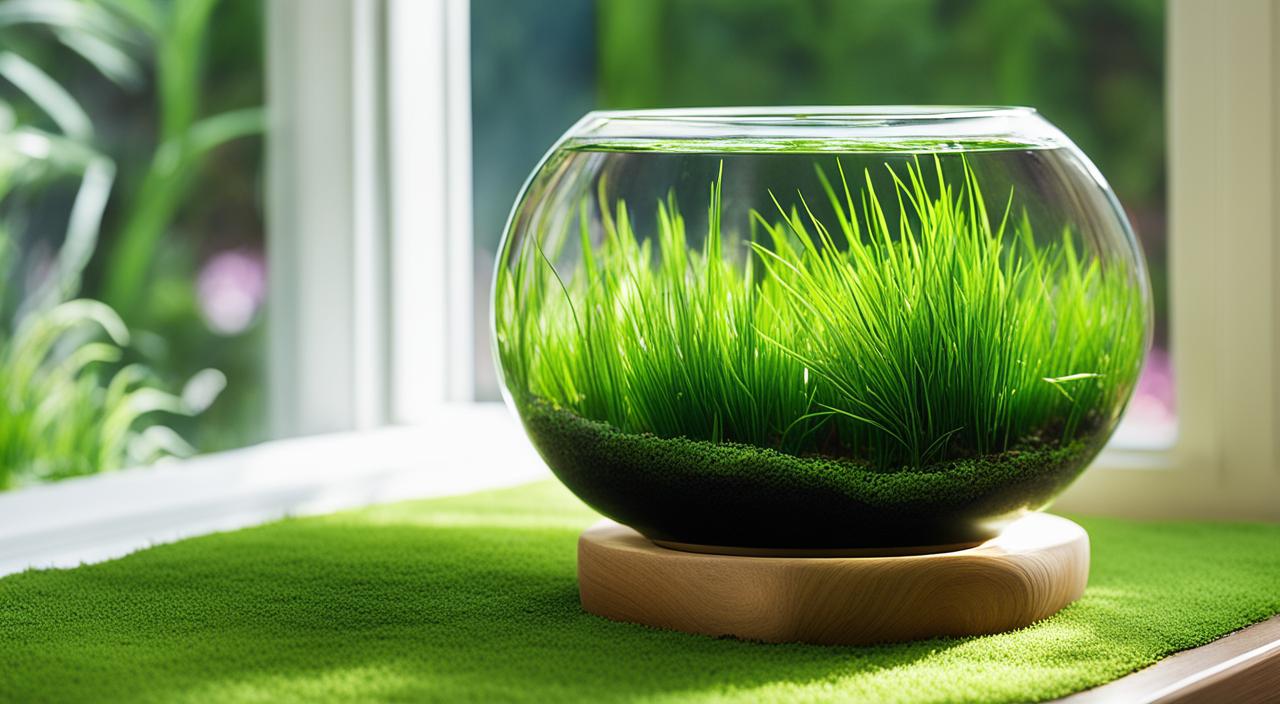Greetings, fellow aquascaping enthusiasts! Today, I am excited to introduce you to a mesmerizing freshwater moss species – Fissidens Fontanus, also known as Phoenix Moss. This captivating aquatic plant has been gaining popularity among aquarists for its stunning appearance and ease of care. Whether you’re a beginner or an experienced hobbyist, Fissidens Fontanus is a fantastic addition to any aquarium, enhancing its beauty with its feathery texture and vibrant green colour.
Native to the United States, Fissidens Fontanus belongs to the Fissidentaceae family and can naturally grow on wood and rocks in rivers and lakes. This moss species is known for its adaptability, making it an excellent choice for various aquarium conditions. Whether you have low or moderate lighting, Fissidens Fontanus can thrive and create a captivating underwater landscape.
Throughout this article, we will delve into the origins, habitat, morphological characteristics, placement and lighting requirements, suitable tank mates, feeding and fertilization, CO2 injection, care tips, aquarium maintenance, health and disease considerations, and summarize the essentials of Fissidens Fontanus.
Key Takeaways:
- Fissidens Fontanus, also known as Phoenix Moss, is a captivating low-light freshwater moss species.
- It belongs to the Fissidentaceae family and is native to the United States.
- Fissidens Fontanus is highly adaptable and can thrive in various aquarium conditions.
- This moss species enhances the beauty of aquascapes with its feathery appearance and vibrant green colour.
- Whether you’re a beginner or an experienced aquarist, Fissidens Fontanus is an excellent choice for your aquarium.
Brief Overview Of Fissidens Fontanus (Phoenix Moss)
Fissidens Fontanus, also known as Phoenix Moss, is a beautiful aquatic moss that can add brightness and dimension to any planted tank. This newly discovered moss species is characterized by its feathery appearance and vibrant green colour. With its slow growth rate, Fissidens Fontanus is a low-maintenance plant that can be easily propagated in the aquarium. It is highly adaptable and can survive in many aquarium parameters, making it suitable for beginners and experienced aquarists.
Regarding growth rate, Fissidens Fontanus is known for its slow and steady development. This makes it ideal for aquarists who prefer a moss that doesn’t require frequent trimming or maintenance. The slow growth rate also allows Fissidens Fontanus to maintain its well-defined shape and structure in the aquarium, creating a visually appealing focal point.
One of the critical advantages of Fissidens Fontanus is its suitability as a low-light aquarium plant. This moss species can thrive in lower lighting conditions, making it an excellent choice for tanks that do not have intense, direct lighting. It can still display its vibrant green color and lush growth even in low-light environments, providing the aquarium a natural and soothing aesthetic.
Table for Fissidens Fontanus (Phoenix Moss):
| Low to Moderate (50-200 PAR), 5000-7000 Kelvin for optimal colour and growth | Description |
|---|---|
| Scientific Name: | Fissidens Fontanus |
| Common Names: | Phoenix Moss |
| Origin: | North America |
| Height: | 3-10 cm (1.2-4 inches) |
| Growth Rate: | Slow to Moderate |
| Colour: | Deep Green |
| Aquarium Placement: | Foreground to Midground, on rocks or driftwood |
| Water Type: | Freshwater |
| pH: | 5.0 – 7.5 |
| Care Level: | Moderate |
| Light Requirements: | It is not necessary but can promote faster growth |
| CO2 Requirements: | Benefits from liquid fertilizers, especially if CO2 is supplemented: absorbs nutrients from water |
| Temperature: | 68°F – 75°F (20°C – 24°C) |
| Flow Rate: | Low to Moderate; prefers stable conditions without strong currents |
| Propagation: | Division of mature clumps or attaching new growth to substrates |
| Feed Type: | Benefits from liquid fertilizers, especially if CO2 is supplemented: absorbs nutrients from water. |
Regarding light requirements, Fissidens Fontanus (Phoenix Moss) is adaptable but thrives best under specific conditions. A PAR (Photosynthetically Active Radiation) range of 50-200 is suitable, with lower levels promoting slower, healthier growth and higher levels potentially speeding up growth but requiring more maintenance to avoid algae issues. The ideal Kelvin range for the light is between 5000-7000K, which provides a spectrum that supports photosynthesis and enhances the natural colour of the moss. While Phoenix Moss can grow in various lighting conditions, these parameters help achieve optimal health and aesthetic appeal.
Regarding propagation, Fissidens Fontanus is a versatile moss that can be easily propagated in the aquarium. It can be propagated through division or fragmentation, allowing aquarists to expand their collection of this captivating moss. By attaching new shoots to surfaces such as rocks or driftwood, aquarists can encourage the growth and spread of Fissidens Fontanus throughout the aquarium, creating a visually dynamic and lush environment.
Overall, Fissidens Fontanus is a captivating aquatic moss that offers beauty and versatility to aquarium enthusiasts. With its slow growth rate, suitability as a low-light plant and ease of propagation, this moss species has become a popular choice among aquarists. Whether you’re a beginner or an experienced hobbyist, Fissidens Fontanus is sure to enhance the aesthetic appeal of your aquarium.
Origins And Habitat
Fissidens Fontanus, also known as Phoenix Moss, is native to the United States. It was recently discovered and has gained popularity among aquarists for its unique appearance and ease of care. In its natural habitat, Fissidens Fontanus can be found growing on wood and rocks in rivers and lakes. It prefers cooler temperatures and shaded areas, but it can also survive in a variety of conditions. This moss species is capable of attaching itself to various surfaces, making it versatile for aquascaping purposes.
In the wild, Fissidens Fontanus creates beautiful green carpets that enhance the natural aesthetics of aquatic environments. Its ability to attach to surfaces allows it to create intricate patterns and textures, adding depth and visual appeal to aquariums. By recreating its native habitat in the aquarium, aquarists can provide an ideal environment for Fissidens Fontanus to thrive.
When cultivating Fissidens Fontanus in your aquarium, it is vital to consider its origins and habitat. Understanding its natural growth conditions and requirements can help you create a suitable environment and ensure the health and vitality of this captivating freshwater moss species.
| Key Points | Description |
|---|---|
| Origins | Fissidens Fontanus is native to the United States. |
| Habitat | This moss species grows on wood and rocks in rivers and lakes. |
| Adaptability | Fissidens Fontanus can survive in various conditions but prefers cooler temperatures and shaded areas. |
| Attachment | It is capable of attaching itself to various surfaces, making it versatile for aquascaping purposes. |
Morphological Characteristics
Fissidens Fontanus, also known as Phoenix Moss, has unique morphological characteristics that set it apart from other aquatic moss species. It features feathery, dark green leaves that form round-like cushions when grown in the aquarium. The leaves of Fissidens Fontanus are smooth, hairless, and very soft with toothless margins. The plant has a maximum height of 13 cm and produces new leaves along the stem.
Placement And Lighting
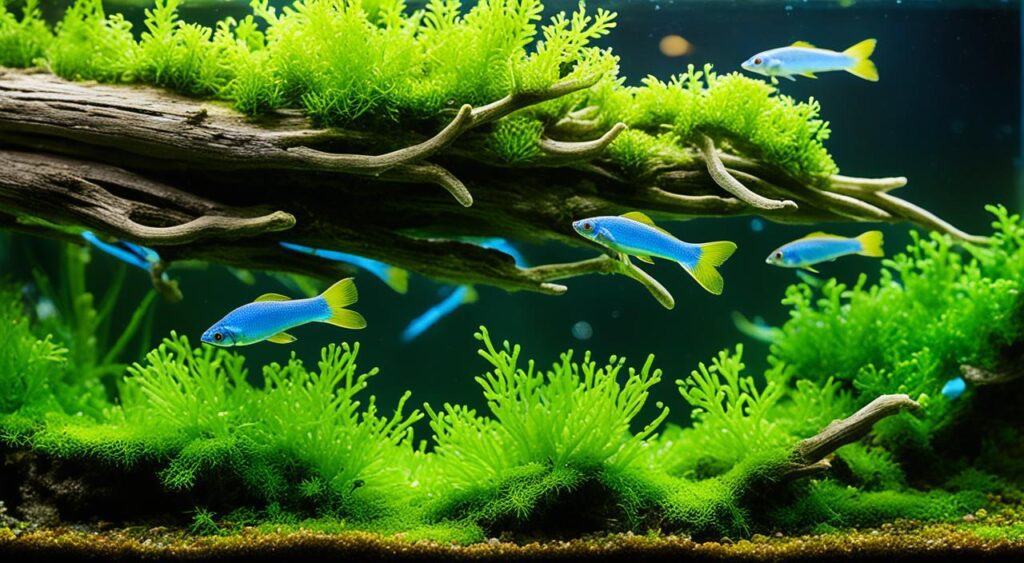
Proper placement and suitable lighting are crucial for the health and growth of Fissidens Fontanus in the aquarium. This moss species can be planted directly into the substrate or attached to surfaces such as rocks or driftwood. It prefers lower lighting conditions and thrives in low to medium light intensity. Excessive light can cause Fissidens Fontanus to turn brown or suffer from algae growth. In this section, we will discuss the optimal placement and lighting requirements for Fissidens Fontanus, providing guidance on how to create the ideal environment for this captivating moss in your aquarium.
When placing Fissidens Fontanus in your aquarium, you have a few options. You can plant it directly into the substrate or attach it to rocks or driftwood. If planting in the substrate, provide a soft and nutrient-rich substrate that allows the moss to anchor itself securely. For attaching to rocks or driftwood, you can use a fishing line or aquarium-safe glue to secure the moss.
In terms of lighting, Fissidens Fontanus prefers lower light conditions. It thrives in low to medium light intensity, typically around 20-50 PAR (Photosynthetically Active Radiation). Avoiding excessive light is essential, as it can cause the moss to turn brown or encourage algae growth. If you notice the moss starting to change colour or experience algae issues, consider reducing the lighting intensity or duration.
When positioning your aquarium lighting, ensure it provides even coverage throughout the tank. Placing the light source slightly above the water’s surface can help create a natural-looking shimmer effect and prevent excessive light from directly hitting the moss. Additionally, consider using a timer to maintain a consistent lighting schedule, providing around 8-10 hours of light per day.
| Placement Tips | Lighting Requirements |
|---|---|
| 1. Plant directly into the substrate or attach to rocks or driftwood | 1. Prefer lower lighting conditions |
| 2. Provide a soft and nutrient-rich substrate for secure anchoring | 2. Thrive in low to medium light intensity (20-50 PAR) |
| 3. Use fishing line or aquarium-safe glue to attach to rocks or driftwood | 3. Avoid excessive light to prevent browning and algae growth |
| 4. Position lighting slightly above the water surface for even coverage | |
| 5. Use a timer for consistent lighting schedule (8-10 hours per day) |
What Are Good Tank Mates?
When selecting tank mates for Fissidens Fontanus, it is crucial to consider compatibility in terms of water parameters, behaviour, and size. Good tank mates for this moss species are peaceful freshwater fish and invertebrates that do not disturb or uproot the moss. Some suitable tank mates include small shoaling fish like tetras, rasboras, and guppies and peaceful invertebrates like shrimp and snails.
This section will explore the concept of good tank mates for Fissidens Fontanus and provide a list of compatible species that can coexist harmoniously with this captivating moss in the aquarium.
Good Tank Mates
Here is a list of compatible species that can be considered good tank mates for Fissidens Fontanus:
- Tetras
- Rasboras
- Guppies
- Shrimp
- Snails
Fish Species To Avoid
While there are many suitable tank mates for Fissidens Fontanus, fish species can be problematic when kept with this moss. Some fish species may nibble on or uproot the moss, causing damage or hindering its growth. It is essential to avoid aggressive or larger fish species that may threaten Fissidens Fontanus.
In this section, we will discuss the fish species to avoid when keeping Fissidens Fontanus, helping you make informed decisions about the inhabitants of your aquarium.
Feeding (Fertilization)
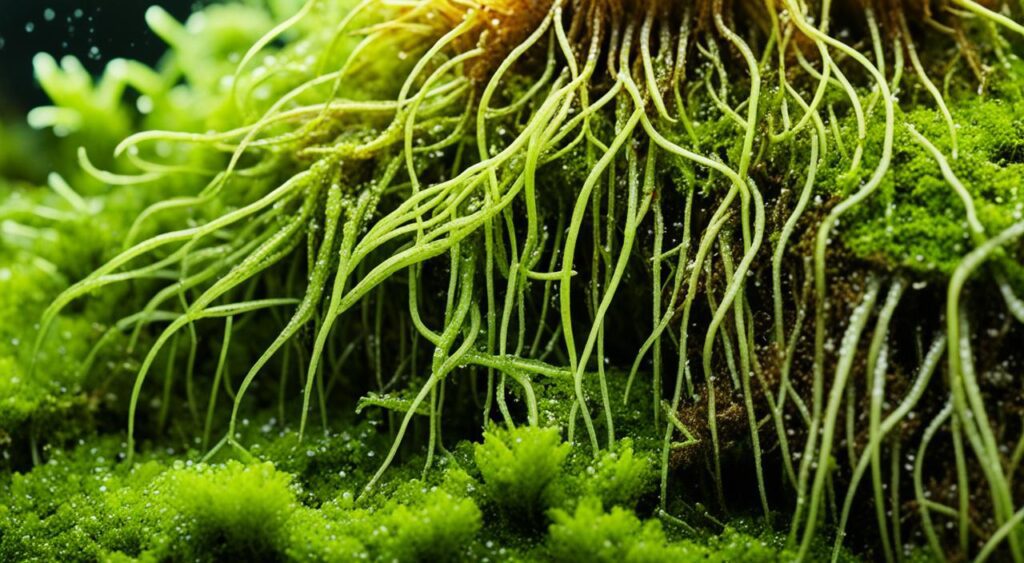
While Fissidens Fontanus primarily obtains nutrients from the water and substrate, providing additional fertilization can enhance its growth and coloration. Regular fertilization is beneficial for this moss species to ensure it receives the necessary macro and micronutrients. The specific frequency and amount of fertilization required will depend on your aquarium’s unique needs and other plants’ presence.
How Much And How Often To Feed
To determine the appropriate amount of fertilizer for Fissidens Fontanus, it is essential to consider the size of your aquarium and the plant’s nutrient requirements. Start with a small amount of fertilizer and gradually increase the dosage if needed. It is crucial to closely monitor the moss’s response to avoid overfertilization, which can lead to algae growth or negatively impact other aquatic plants.
The frequency of fertilization will depend on factors such as the growth rate of the moss, the presence of other fast-growing plants, and the nutrient levels in your aquarium. Generally, it is recommended to fertilize Fissidens Fontanus once a week or every other week. However, it is essential to adjust the frequency based on the specific needs of your aquatic setup.
When selecting a fertilizer, choose one that provides a balanced mix of essential nutrients, including nitrogen, phosphorus, and potassium (NPK). Additionally, consider using a micronutrient supplement to ensure the moss receives adequate trace minerals.
It is essential to carefully follow the instructions provided by the fertilizer manufacturer and make adjustments based on the specific requirements of Fissidens Fontanus.
CO2 Injection
Adding carbon dioxide (CO2) can significantly enhance the growth and vitality of Fissidens Fontanus, also known as Phoenix Moss, in your aquarium. CO2 injection is a widely popular method used by aquarists to provide this essential gas to aquatic plants and promote their healthy development.
Different types of CO2 injection systems are available for aquarium use, each with advantages and considerations. Two standard options include:
Pressurized CO2
The pressurized CO2 system involves using a CO2 cylinder that contains compressed carbon dioxide. The gas is regulated and delivered to the aquarium through a diffuser or atomizer. This method allows for precise control over CO2 levels, ensuring plants receive the correct amount for optimal growth. It is particularly effective for larger aquariums or those with high-demand plant species.
Liquid Carbon Supplements
Liquid carbon supplements, or liquid CO2, are an alternative to pressurized CO2 systems. These supplements often contain carbon that is readily available for plants to utilize. While not as potent as pressurized CO2, liquid carbon supplements can still provide beneficial effects and are suitable for smaller aquariums or those with lower-demand plant species.
When implementing CO2 injection, it is essential to consider the specific requirements of Fissidens Fontanus. Providing the appropriate amount of CO2 will help enhance its growth and vibrant colouration. Ensure that you monitor and adjust CO2 levels according to the needs of your aquarium and observe the response of the plants to ensure they are thriving.
Care
Planted Tank Parameters
Fissidens Fontanus, also known as Phoenix Moss, requires specific planted tank parameters to thrive. These parameters include:
- Substrate: Provide a suitable substrate for Fissidens Fontanus, such as fine gravel or moss-friendly substrates.
- Temperature: Maintain a temperature range of 68-78°F (20-26°C) to ensure optimal growth.
- pH: Maintain a slightly acidic to neutral pH between 6.0 and 7.5.
- Water Hardness: Fissidens Fontanus prefers soft to moderately complex water with a hardness level between 2-15 dGH.
By providing these planted tank parameters, you can create an ideal environment for Fissidens Fontanus to thrive in your aquarium.
Water Quality
The water quality of your aquarium is crucial for the health and well-being of Fissidens Fontanus. Follow these guidelines to maintain optimal water quality:
- Regular Water Changes: Perform regular water changes to keep the water clean and remove accumulated waste or toxins.
- Water Testing: Test the water parameters regularly, including pH, ammonia, nitrite, nitrate, and carbonate hardness, to ensure they remain within the appropriate range for Fissidens Fontanus.
- Acidity and Alkalinity: Maintain slightly acidic to neutral water conditions with a pH between 6.0 and 7.5.
By maintaining clean and stable water quality, you can help create an optimal environment for the growth and well-being of Fissidens Fontanus.
Filtration
Proper filtration is essential for maintaining water clarity and removing debris that may accumulate in the aquarium. Fissidens Fontanus can benefit from the following filtration considerations:
- Mechanical Filtration: Use mechanical filtration components such as filter floss or sponges to trap solid waste particles and prevent them from settling on the moss.
- Chemical Filtration: Utilize activated carbon or other chemical filtration media to remove impurities or odours from the water.
- Biological Filtration: Encourage the growth of beneficial bacteria by providing a suitable biological filtration system to break down harmful substances.
By maintaining proper filtration, you can ensure the water quality necessary for the healthy growth of Fissidens Fontanus.
Flow
The flow rate in the aquarium plays a crucial role in the health and well-being of Fissidens Fontanus. Consider the following flow requirements:
- Moderate Flow: Avoid excessive water flow that may cause Fissidens Fontanus to uproot or suffer from damage. Aim for a moderate flow rate that mimics the natural habitat of the moss.
- Gentle Water Movement: Fissidens Fontanus benefits from gentle water movement that allows for proper oxygenation without causing excessive movement of the moss.
- Positioning: Place ornaments, rocks, or driftwood strategically to create barriers or redirect water flow, ensuring it doesn’t directly impact the moss.
By maintaining the appropriate flow rate, you can provide a suitable environment for Fissidens Fontanus to thrive and showcase its full beauty in your aquarium.
| Planted Tank Parameters | Water Quality | Filtration | Flow |
|---|---|---|---|
| Provide appropriate substrate | Perform regular water changes | Use mechanical filtration components | Avoid excessive water flow |
| Maintain temperature range of 68-78°F (20-26°C) | Test water parameters regularly | Utilize chemical filtration media | Ensure gentle water movement |
| Maintain pH level between 6.0 and 7.5 | Maintain slightly acidic to neutral water conditions | Encourage biological filtration | Position ornaments strategically |
| Maintain water hardness between 2-15 dGH |
Aquarium Maintenance
Proper maintenance is essential for the overall health and longevity of your Fissidens Fontanus (Phoenix Moss) aquarium. Regular testing of water conditions, setting up your tank, and employing effective propagation methods are vital aspects of successful aquarium maintenance.
Testing Water Conditions
Regularly testing the water conditions in your aquarium is crucial for ensuring the optimal health of Fissidens Fontanus. By monitoring parameters such as pH, ammonia, nitrite, and nitrate levels, you can make necessary adjustments and maintain the ideal water conditions for this moss species to thrive.
How To Set Up Your Aquarium Tank
Properly setting up your aquarium tank is essential for creating an environment conducive to the growth and well-being of Fissidens Fontanus. This includes selecting a suitable substrate, providing adequate lighting, and establishing a balanced ecosystem miming its natural habitat. Consider placing the tank in an area with indirect sunlight and avoid it near heat sources or cold drafts. Additionally, ensure proper filtration and maintain suitable water flow to prevent debris build-up and promote water circulation.
Propagation Methods
Fissidens Fontanus can be propagated through various methods, including division, fragmentation, and attaching new shoots to surfaces. Understanding these propagation techniques can help you expand your collection of this captivating moss. By carefully separating the moss or breaking it into smaller sections, you can encourage the growth of new plants. Additionally, attaching the new shoots to surfaces such as rocks, driftwood, or mesh can help establish new patches of Fissidens Fontanus in your aquarium.
| Testing Water Conditions | How To Set Up Your Aquarium Tank | Propagation Methods |
|---|---|---|
| Select the right substrate, provide adequate lighting, and establish a balanced ecosystem. | Select the suitable substrate, provide adequate lighting, and establish a balanced ecosystem. | Use division, fragmentation, or attaching new shoots to propagate the moss |
| Make necessary adjustments to maintain optimal water conditions | Avoid direct sunlight, heat sources, and cold drafts | Encourage the growth of new plants by separating or breaking the moss |
| Ensure proper filtration and maintain suitable water flow | Attach new shoots to surfaces such as rocks or driftwood |
Health And Disease
Ensuring the health and well-being of Fissidens Fontanus, also known as Phoenix Moss, is crucial for maintaining a vibrant and thriving aquatic environment. By understanding the signs of good and poor health, joint health issues, and effective preventive measures, you can provide the necessary care and treatment to keep your moss in optimal condition.
Signs Of Good Health
It is essential to observe signs of good health in Fissidens Fontanus to ensure its vitality. Lush and vibrant growth, absence of discolouration or damage, and active growth are indicators that your moss is in good health. Taking note of these signs allows you to assess the success of your care practices and make any necessary adjustments to maintain its well-being.
Signs Of Poor Health
Recognizing signs of poor health in Fissidens Fontanus is crucial for timely intervention and preventing further decline. Yellowing or browning of leaves, stunted growth, and signs of decay can indicate underlying health issues. If you notice these signs, it is essential to investigate the cause and take appropriate action to address your health concerns.
Common Health Issues And Treatment
Fissidens Fontanus can be susceptible to various health issues, including nutrient deficiencies, algae overgrowth, and infections. Identifying the common health issues that affect your moss and implementing appropriate treatments can help restore its health and well-being. Nutrient supplementation, algae control measures, and targeted therapy for infections can all contribute to the recovery and overall health of your Fissidens Fontanus.
Plant Pests
Like all plants, Fissidens Fontanus can be vulnerable to plant pests, including snails and algae. Preventive measures such as proper tank maintenance, regular cleaning, and quarantine procedures for new additions can help minimize the risk of infestations. If pests are present, suitable pest control methods should be used to protect your moss from these nuisances and ensure its long-term health.
The image above illustrates the importance of preventing and treating plant pests in aquatic moss, including Fissidens Fontanus.
Summary
In conclusion, Fissidens Fontanus, also known as Phoenix Moss, is a captivating low-light freshwater moss variety that can add beauty and dimension to your aquascape. With its feathery appearance, unique morphological characteristics, and ease of care, Fissidens Fontanus is an excellent choice for aquarists of all skill levels.
By providing suitable placement and lighting, selecting compatible tank mates, feeding and fertilizing appropriately, and maintaining optimal tank conditions, you can ensure the health and vitality of this moss species in your aquarium.
In this article, we have explored the origins and habitat of Fissidens Fontanus, its morphological characteristics, care requirements, aquarium maintenance tips, health considerations, and propagation methods. Following these guidelines, you can create a thriving and visually stunning aquatic environment with this captivating moss.
FAQ
What is Fissidens Fontanus?
Fissidens Fontanus, also known as Phoenix Moss, is a low-light freshwater moss variety that can enhance the beauty of your aquascape.
What are the origins and habitat of Fissidens Fontanus?
Fissidens Fontanus is native to the United States and can be found growing on wood and rocks in rivers and lakes.
What are the morphological characteristics of Fissidens Fontanus?
Fissidens Fontanus has feathery, dark green leaves that form round-like cushions and grows up to 13 cm in height.
Where should I place Fissidens Fontanus in my aquarium and what are its lighting requirements?
Fissidens Fontanus can be planted in the substrate or attached to surfaces like rocks or driftwood. It thrives in low to medium light intensity.
What are good tank mates for Fissidens Fontanus?
Good tank mates for Fissidens Fontanus include small shoaling fish like tetras, rasboras, and guppies, as well as peaceful invertebrates like shrimp and snails.
What should I feed Fissidens Fontanus and how often?
Fissidens Fontanus primarily obtains nutrients from the water and substrate, but supplementing its diet with fertilizers can promote healthier growth. The frequency and amount of fertilization will depend on your aquarium’s specific needs.
Should I use CO2 injection for Fissidens Fontanus growth?
Adding carbon dioxide (CO2) can enhance the growth and vitality of Fissidens Fontanus, and there are different types of CO2 injection systems available.
What are the planted tank parameters and water quality requirements for Fissidens Fontanus?
Fissidens Fontanus prefers slightly acidic to neutral water conditions and requires proper filtration and moderate water flow.
How do I test water conditions and set up my aquarium for Fissidens Fontanus?
Regularly testing water parameters and setting up an appropriate substrate, lighting, and ecosystem are crucial for the health of Fissidens Fontanus. Various propagation methods can also help expand your collection of this moss species.
What are the signs of good health and poor health in Fissidens Fontanus?
Signs of good health in Fissidens Fontanus include lush growth and active growth, while signs of poor health can include discoloration, stunted growth, and decay.
What are the common health issues and pests that can affect Fissidens Fontanus?
Fissidens Fontanus can experience nutrient deficiencies, algae overgrowth, and infections. It can also be vulnerable to pests like snails and algae.

